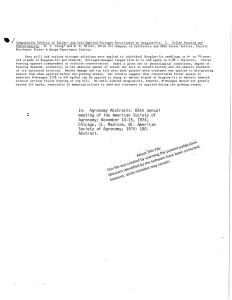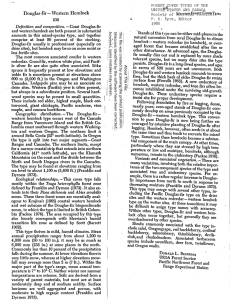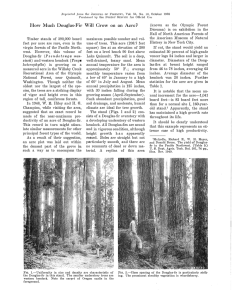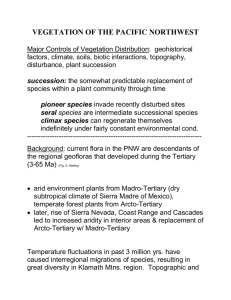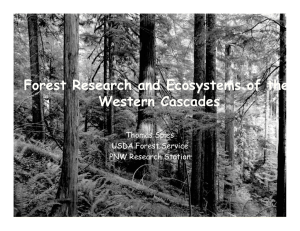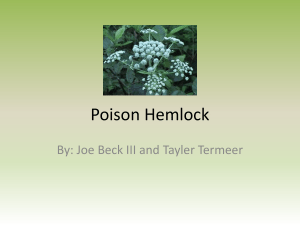Old-Growth Douglas-Fir and Western Hemlock: Year
advertisement
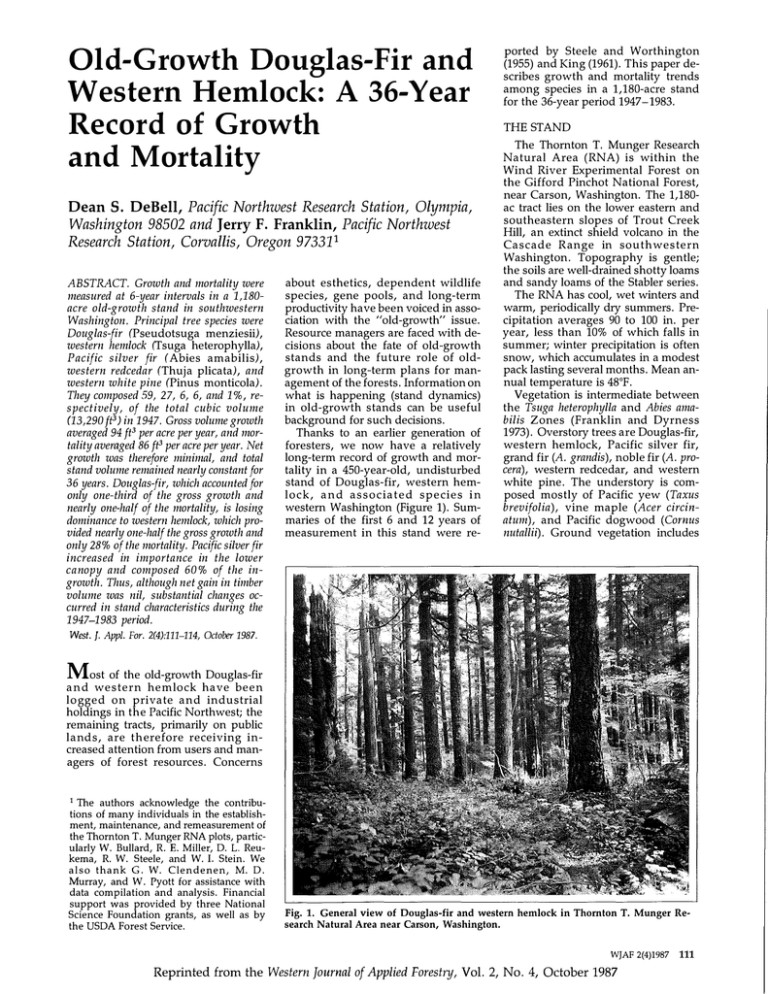
Old-Growth Douglas-Fir and
Western Hemlock: A 36-Year
Record of Growth
and Mortality
Dean
S. DeBell, Pacific Northwest Research Station, Olympia,
Washington 98502 and Jerry F. Franklin, Pacific Northwest
Research Station, Corvallis, Oregon 973311
ABSTRACT. Growth and mortality were
measured at 6-year intervals in a 1,180­
acre old-growth stand in southwestern
Washington. Principal tree species were
Douglas-fir (Pseudotsuga menziesii),
western hemlock (Tsuga heterophylla),
P acific silver fir (Abies amabilis),
western redcedar (Thuja plicata), and
western white pine (Pinus monticola).
The1J composed 59, 27, 6, 6, and 1%, re­
spectively, of the total cubic volume
(13,290 jr) in 1947. Gross volume growth
averaged 94 jr per acre per year, and mor­
tality averaged 86 jr per acre per year. Net
growth was therefore minimal, and total
stand volume remained nearly constant for
36 years. Douglas-fir, which accounted for
only one-third of the gross growth and
nearly one-half of the mortality, is losing
dominance to western hemlock, which pro­
vided nearly one-half the gross growth and
only 28% of the mortality. Pacific silver fir
increased in importance in the lower
c a nopy and composed 60% of the in­
growth. Thus, although net gain in timber
volume was nil, substantial changes oc­
curred in stand characteristics during the
1947-1983 period.
West.
J. Appl.
about esthetics, dependent wildlife
species, gene pools, and long-term
productivity have been voiced in asso­
ciation with the "old-growth" issue.
Resource managers are faced with de­
cisions about the fate of old-growth
stands and the future role of old­
growth in long-term plans for man­
agement of the forests. Information on
what is happening (stand dynamics)
in old-growth stands can be useful
background for such decisions.
Thanks to an earlier generation of
foresters, we now have a relatively
long-term record of growth and mor­
tality in a 450-year-old, undisturbed
stand of Douglas-fir, western hem­
lock, and associated species i n
western Washington (Figure 1). Sum­
maries of the first 6 and 12 years of
measurement in this stand were re­
ported by Steele and Worthington
(1955) and King (1961). This paper de­
scribes growth and mortality trends
among species in a l,180-acre stand
for the 36-year period 1947-1983.
THE STAND
The Thornton T. Munger Research
Natural Area (RNA) is within the
Wind River Experimental Forest on
the Gifford Pinchot National Forest,
near Carson, Washington. The 1,180­
ac tract lies on the lower eastern and
southeastern slopes of Trout Creek
Hill, an extinct shield volcano in the
Cascade R ange in southwestern
Washington. Topography is gentle;
the soils are well-drained shotty loams
and sandy loams of the Stabler series.
The RNA has cool, wet winters and
warm, periodically dry summers. Pre­
cipitation averages 90 to 100 in. per
year, less than 10% of which falls in
summer; winter precipitation is often
snow, which accumulates in a modest
pack lasting several months. Mean an­
nual temperature is 48°F.
Vegetation is intermediate between
the Tsuga heterophylla and Abies ama­
bilis Zones (Franklin and Dyrness
1973). Overstory trees are Douglas-fir,
western hemlock, Pacific silver fir,
grand fir (A. grandis), noble fir (A. pro­
cera), western redcedar, and western
white pine. The understory is com­
posed mostly of Pacific yew (Taxus
brevifolia), vine maple (Acer circil1­
atum), and Pacific dogwood (Comus
nutallii). Ground vegetation includes
For. 2(4):111-114, October 1987.
M
ost of the old-growth Douglas-fir
a n d w e s t e r n hemlock have been
l o gged o n private and industrial
holdings in the Pacific Northwest; the
remaining tracts, primarily on public
l a nds, are t h erefore receiving in­
creased attention from users and man­
agers of forest resources. Concerns
1 The authors acknowledge the contribu­
tions of many individuals in the establish­
ment, maintenance, and remeasurement of
the Thornton T. Munger RNA plots, partic­
ularly W. Bullard, R. E. Miller, D. 1. Reu­
kema, R. W. Steele, and W. I. Stein. We
a l s o t h a nk G. W. Cle n de n e n , M. D .
Murray, and W. Pyott for assistance with
data compilation and analysis. Financial
support was provided by three National
Science Foundation grants, as well as by
the USDA Forest Service.
Fig. 1. General view of Douglas-fir and western hemlock in Thornton T. Munger Re­
search Natural Area near Carson, Washington.
WJAF 2(4)1987
Reprinted from the
Western Journal of Applied Forestry, Vol. 2, No.4, October 1987
111
salal (Gaultheria shallon), Oregon-grape
(Berberis nervosa), vanilla-leaf (Achlys
triphylla), beargrass (Xerophyllum
tenax), and red whortleberry (Vac­
cinium parvifolium). Douglas-firs in the
RNA are 230-460 years old, based on
ring counts on stumps in adjacent
clearcuts (Franklin and Waring 1979),
suggesting that the stand originated
after a major disturbance more than
450 years ago. Douglas-fir site class
varies from Site III to Site IV (McArdle
et al. 1961).
Table 1. Inventory of old-growth stand in Thornton T. Munger Research Natural Area in 1947
{per-acre basis).1
Volume
Species
Trees
Dq2
Cubic
Scribner3
Douglas-fir
Western hemlock
True firs6
Western redcedar
Western white pine
Miscellaneous
Total or average
Number
24
77
43
5
1
25
175
Inches
37
14
9
26
26
5
18
Cunits4
78.3
36.4
8.4
7.8
1.4
0.6
132.9
mbfs
53.2
21.5
3.8
5.5
1 Includes all stems
2.5 in. dbh and larger.
0,'1
8L(.
2 Quadratic mean diameter.
PROCEDURES
Inventory and gross growth data
were gathered on 50 concentric plots,
1/20 ac and Vs ac in size. Plots were
spaced systematically throughout the
area at a rate of approximately two per
40 ac. Trees 2.5 to 9.5 in. dbh were
tagged and tallied on the V2o-ac plots,
and trees exceeding 9.5 in. dbh were
tagged and measured on the lfs-ac
plots. Sampling intensity was about
1% for the larger trees and 0.25% for
the smaller trees. Diameters of all
trees on these plots were measured by
diameter tape to the nearest 0.1 in. ;
heights of 6 or more trees per plot
were measured to the nearest foot by
Abney level and chain. Mortality data
were collected on continuous cruise
strips, 2 chains wide, spaced 20 chains
apart. Diameters of trees that died
since the last measurement were esti­
mated to the nearest 2 in.
The plots have been measured
every 6 years since 1947. Mortality
strips were checked every 2 years
from 1947-1959, but since 1959 they
have been evaluated at the 6-year
measurement intervals.
Equations for estimating height
from diameter were developed from
our data for each tree species. The
measured diameter and estimated
height of each tree were then applied
to appropriate regional volume equa­
tions (Browne 1962) to obtain cubic­
foot volume per tree. These values
were then summed for all trees on
each plot to provide volume per unit
area. Inventory and gross growth are
estimated from data collected periodi­
c ally on the circular plots. Gross
growth includes increment on all trees
tallied at the previous measurement
plus ingrowth; i.e., volume of trees at­
taining measurable size for the first
time during the growth period. Mor­
tality was calculated from the cruise
strips and was subtracted from gross
growth to provide estimates of net
growth. Board-foot volume (Scribner,
16-ft logs) and volume growth were
estimated from ratios calculated from
past measurements of cubic- and
board-foot volumes in the study plots.
112
WJAF 2(4)1987
3 Sixteen-foot logs.
cunit is equal to 100 ft3•
S Thousand board feet.
6 Grand, noble, and Pacific silver firs combined.
4A
RESULTS
Growth and Mortality (1947 to 1983)
The Stand in 1947
The initial inventory showed an
average of 175 trees per acre, with es­
timated volumes of 13,290 ftJ or 93,000
bd ft (Table 1). Minor discrepancies
between these data and earlier reports
(Steele and Worthington 1955, King
1961) may be attributed to revised
height-diameter relationships and im­
proved volume equations.
Douglas-fir and western hemlock
constituted 80-90% of the stand
volume in 1947 (Table 1). There were
three times as many hemlock trees as
Douglas-fir trees, but the latter were
substantially larger and contributed
more than twice as much volume per
acre as did the hemlock trees. True firs
accounted for 25% of the stems, but
these were small and constituted only
6% of the stand volume. Except for
two swampy plots where western red­
cedar dominated the stand, both red­
cedar and western white pine were
scattered throughout the tract. Al­
though few in number, individual
trees of these species were large, and
they contributed sizably to stand
volume (7% of cubic volume; 16% of
board-foot volume).
Gross growth during the 36-year pe­
riod was nearly 3,400 ftJ per acre, rep­
resenting an average annual incre­
ment of 94 ftJ per acre (Table 2). Esti­
mated Scribner gross volume growth
was more than 20,000 bd ft or about
565 bd ftlaclyr. Gross growth varied
considerably by period, however
(Figure 2). During the 1947-1953 pe­
riod, gross increment was twice that
of the 1965-1971 period. Western
hemlock accounted for nearly 50% of
gross volume growth, Douglas-fir con­
tributed another 34%, and true firs
provided two-thirds of the remaining
16%.
Mortality was an important process
in this stand (Table 2, Figure 2). About
3,100 ftJ/ac were lost during the 36-yr
period, or 86 ft3/ac/yr. Equivalent
Scribner volume of the mortality was
19,360 bd ft/ac, or 538 bd ftlac/yr. Mor­
tality also varied by period; losses
during the 1947-1953 period averaged
650 bd ft/aclyr and were higher than
losses in other periods. During the en­
tire 36-yr period, Douglas-fir ac­
counted for about 50% of the loss,
western hemlock for 28%. Western
white pirie was a minor component of
the stand, but it contributed dispro-
Table 2. Gross growth, mortality, and net growth per acre (1947 -83) by species, Thornton T.
Munger Research Natural Area.
Conversion ratio1
Species
Douglas-fir
Western hemlock
True firs2
Western redcedar
Western white pine
Miscellaneous
Total
Per annum
Gross
growth
Mortality
Net
growth
Gross
growth
Mortality
...................... Cubic-foot volume (total stem) ......................
-393
6.5
1,531
6.8
1,138
6.2
+816
854
1,670
5.9
4.7
238
4.5
+147
385
80
6.5
137
7.0
+57
-371
6.5
381
7.0
10
18
+21
39
3,102
+277
3,379
86
+8
94
1 Estimated board feet (16-ft logs) per ft3.
2 Grand, noble, and Pacific silver firs combined.
o
160
•
Live volume
Mortality Gross growth
>­
=
'i 120 co
...
..
o
1"11
......
III ...
E
10 (;
'2 _G.
- 80
8 :Sf
u
I
::i
e
6 CI!l
g: '2
40 4
2
1947
1953
1959
1965
1971
1977
1983
e].
CI
u
.;:
o
Fig. 2. Live volume, gross growth, and mortality i old-growth Douglas-fir-western
hemlock stand in Thornton T. Munger Research Natural Area (1947-1983).
portionately to mortality because most
of the western white pine died.
Causes of mortality varied by both
species and period. In the early 1950s,
Douglas-fir bark beetles (Dendroctonus
pseudotsugae) were the principal cause
of Douglas-fir mortality, and white
pine blister rust (Cronartium ribicoZa)
and mountain pine beetle (D. ponder­
osae) killed most of the white pine.
Root and butt rots have been a major
cause of mortality in Douglas-fir and
western hemlock the past two decades
and have often resulted in windthrow
or windbreak of stems. Windthrow
6.0
has been a major cause of mortality of
western hemlock and Pacific silver fir.
Heavy mistletoe (Arceuthobium campy­
lopodum f. laricis) infections weaken
and probably kill western hemlock
and, to a lesser extent, Pacific silver
fir.
Net change in stand v o lume is
closer to zero for the 36-yr period be­
cause extensive mortality offset the
large gross volume growth (Table 2,
Figure 2). Total net growth was 277
fr/ac or 990 bd ftlac; per annum equiv­
alents are 8 fr/ac and 28 bd ftlac. Such
net growth resulted in a total increase
60
Douglas-fir
5.0
50
g 4.0
40
Q)
...
Western hemlock
...
Q)
Q.
If)
Q)
I-
3.0 30
2.0
20
4.0
40
Western redcedar
Q)
;:; 3.0 30
10
...
Q)
Q.
If)
Q)
I-
True fir
2.0 20
1.0 10
12
24
36
48
60
6-inch dbh classes
72
o
01947
.1983
12
24
36
48
60
6-inch dbh classes
Fig. 3. Diameter distribution of principal species, by 6-in classes, in old-growth
Douglas-fir-western hemlock stand in Thornton T. Munger Research Natural Area, 1947
and 1983.
of only 1 to 2% of 1947 volume and
probably is not significantly different
from zero.
Changes in Stand Structure
nd Composition
Although growth and mortality are
essentially in balance for the stand as a
whole, major differences occurred
among individual species. Substantial
net losses occurred in Douglas-fir and
western white pine, whereas net gains
were achieved by western hemlock,
true firs, and western redcedar (Ta­
ble 2).
Diameter distributions of principal
tree species in 1947 and 1983 provide
an indication of the changes occurring
in stand structure (Figure 3). Douglas­
fir lost 3. 4 trees/ac, and surviving trees
were generally in larger size classes.
Diameters are distributed in the bell­
shaped pattern typical of intolerant
species in even-aged stands. There
were no Douglas-firs in the 6-in dbh
class in either 1947 or 1983. Western
hemlock and true fir also had fewer
trees (5.6 and 8.3, respectively) in 1983
than in 1947, and trees have grown
into larger diameter classes. The diam­
eters of both western hemlock and the
trueJirs were distributed in an in­
verse-} pattern, typical of uneven­
aged stands and tolerant species.
Western redcedar gained an average
of 1. 0 tree per acre during the period.
More than half the western redcedar
stems were in the smallest size class,
but there was a normal distribution of
the remaining trees in the larger size
classes.
The changing importance of various
species or species groups to stand
processes can be seen more clearly by
comparing species in terms of their
relative contribution to initial inven­
tory, gross growth, ingrowth, and
mortality ( Table 3). Douglas-fir consti­
tuted 59% of the stand volume in
1947, but during the next 36 years con­
tributed substantially less of the gross
volume growth (34%), provided no in­
growth, and accounted for nearly half
of all mortality. Western hemlock, on
the other hand, contributed far more
to gross growth on a percentage basis
than it did to original stand volume;
relative contributions to ingrowth and
mortality are similar to each other and
to initial stand volume (26 to 28%).
The true firs contributed 11 % of the
gross growth and 60% of all ingrowth,
even though they accounted for only
6% of initial stand volume. Western
redcedar has more or less held its own
in the stand. Western white pine was
essentially eliminated from the stand
by insects and disease.
DISCUSSION AND CONCLUSIONS
This 36-yr record of growth and
mortality in a 450-yr-old stand illus-
WJAF 2(4)1987
113
Table 3. Species contributions to initial inventory, gross growth, ingrowth, and mortality be­
tween 1947 and 1983.
Inventory,
Species
Douglas-fir
Western hemlock
True firs1
Western redcedar
Western white pine
Miscellaneous
Total
1947
Gross
growth
Ingrowth
Mortality
............................ % of total cubic feet ............................ 0
49
26
27
28
6
60
11
8
6
6
4
3
1
1
0
12
1
1
8
1
............................... Cunits per acre ............................... 132.9
31.0
0.1
33.8
1 Grand, noble, and Pacific silver firs combined.
trates some patterns common to many
old-growth Douglas-fir and western
hemlock stands in the Pacific North­
west. Wood volume (and presumably
total living biomass) have remained
essentially constant, despite much ac­
tivity in growth and development pro­
cesses.
Gross volume growth was larger
than many foresters might expect for
an old-growth stand (94 £t3/ac/yr).
Such gross productivity is equivalent
to about one-half of that in 60- to 100­
yr-old Douglas-fir stands on sites of
similar quality. Mortality in the old­
g rowth stand was also very high
(86 ft3/ac/yr), and it essentially bal­
anced gross growth. Mortality losses
in younger stands, even when un­
thinned, on similar sites are much
lower.
Net volume growth resulted in a
1983 stand volume that was only
1-2% greater than the 1947 volume.
Such net growth was probably not sig­
nificantly different from zero, espe­
cially in view of the fact that losses in
usable volume caused by decay in
living trees were not evaluated in our
study. In contrast, net growth of
Douglas-fir stands on rotations of 60
to 100 years averages about 150 fr/ae!
yr (Curtis et al. 1982), nearly all of
which is recoverable.
Important shifts have occurred (and
are continuing to occur) in the relative
importance of various tree species.
The stand is shifting gradually from
Douglas-fir dominance in the upper
canopy to western hemlock; simulta­
neously, true firs and western red­
cedar are increasingly represented in
the lower crown classes.
Demonstration of the ever-changing
nature of old-growth stands is prob­
ably the most important contribution
of this 36-yr record. Although the net
change in timber volumes was nil,
processes and changes are as dynamic
as those observed in many much
younger stands. Hence, characteristics
or functions of old-growth stands
cannot be guaranteed in perpetuity by
simply preserving existing old-growth
tracts. Where desired old-growth
forests attributes are transient, long­
term management strategies must in­
clude plans to recreate stands with
those attributes. More information on
patterns and rates of change in old­
growth forests is clearly essential for
identifying the nature and intensity of
D
such problems.
LITERATURE CITED
BROWNE, J. E. 1962. Standard cubic-foot volume
tables for the commercial tree species of British
Columbia. B.C. For. Serv., For. Servo & Inven­
tory Div., Victoria, B.C. 107 p.
CURTIS, R. 0., ET AL. 1982. Yield tables for man­
aged stands of coast Douglas-fir. USDA For.
Servo Gen. Tech. Rep. PNW-135. 182 p.
FRANKLIN, J. F., AND C. T. DYRNESS. 1973. Nat­
ural vegetation of Oregon and Washington.
USDA For. Servo Gen. Tech. Rep. PNW-80.
417 p.
FRANKLIN, J. F., AND R. H. WARING. 1979. Dis­
tinctive features of the northwestern conif­
erous forest: Development, structure, and
function, P. 59-86 ill Forests: Fresh perspec­
tives from ecosystem analysis (R. H. Waring,
ed.). Oregon State Univ. Press, Corvallis.
KING, J. P. 1961. Growth and mortality in the
Wind River Natural Area. J. For. 59(10):768­
769.
McARDLE, R. E., W. H. MEYER, AND D. BRUCE.
1961. The yield of Douglas-fir in the Pacific
Northwest. USDA Tech. Bull. 201 (rev.), 74 p.
STEELE, R. W., AND N. P. WORTHINGTON. 1955.
Increment and mortality in a virgin Douglas-fir
forest. USDA For. Servo Pac. Northwest For. &
Range Exp. Stn. Res. Note 110. 6 p.
Purchased by the Forest Service
U.S. Department of Agriculture,
for official us
114
WJAF 2(4)1987
About this file: This file was created by scanning the printed publication. Some mistakes introduced by scanning may remain.
